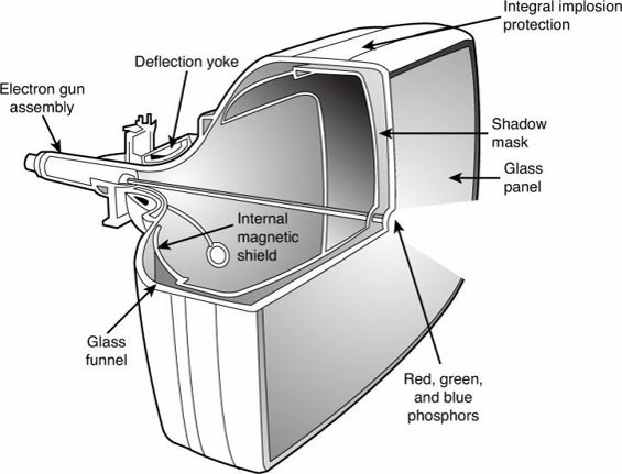Hardware Reference
In-Depth Information
Figure 12.25. A typical CRT monitor is a large vacuum tube. It contains three electron guns
(red, green, and blue) that project the picture toward the front glass of the monitor. High
voltage produces the magnetism that controls the electron beams that create the picture
displayed on the front of the CRT.
The phosphor chemical has a quality called
persistence
, which indicates how long this glow remains
onscreen. Persistence is what causes a faint image to remain on your TV screen for a few seconds
after you turn off the set. The vertical scanning frequency (also called the
refresh rate
) of the display
specifies how many times per second the image is refreshed. You should have a good match between
persistence and refresh rate so the image has less flicker (which occurs when the persistence is too
low) and no ghost images (which occurs when the persistence is too high).
The electron beam moves quickly, sweeping the screen from left to right in lines from top to bottom,
in a pattern called a
raster
. The horizontal scan rate refers to the speed at which the electron beam
moves laterally across the screen, measured in the number of lines drawn per second.
During its sweep, the beam strikes the phosphor wherever an image should appear onscreen. The
beam also varies in intensity to produce different levels of brightness. Because the glow begins to
fade almost immediately, the electron beam must continue to sweep the screen to maintain an image—
a practice called
redrawing
or
refreshing
the screen.
Due to the lower persistence phosphors used in PC monitor CRTs, most have an ideal refresh rate
(also called the
vertical scan frequency
) of 85Hz, which means the screen is refreshed 85 times per
second. Refresh rates that are too low cause the screen to flicker, contributing to eyestrain.
Plasma Display Technology
Plasma displays have a long history in PCs. In the late 1980s, IBM developed a monochrome plasma
screen that displayed orange text and graphics on a black background. IBM used a 10-inch version of

